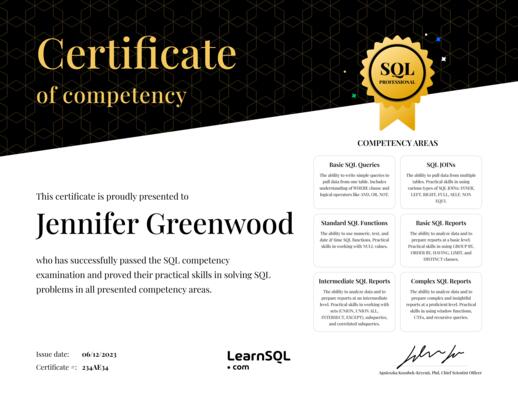Basic Course
Standard SQL Functions
Learn how to process numerical, text, and other types of data with SQL’s most-used functions.
4.90
59,181 learners enrolled
Free trial Yes
Certificate of completion Yes
Time to complete 18 h
Coding challenges 211
Skills you will gain
- Utilize common SQL text functions
- Identify and use standard SQL numeric functions
- Select and implement SQL date and time functions
- Work with NULLs in standard SQL functions
- Understand SQL aggregate functions
- Plus, you’ll get to practice your skills on 211 interactive exercises.
Last reviews
Description
Introduce yourself to the standard SQL functions used in data processing. This course shows you how to use SQL to work with the following data types:
- Text
- Numeric
- Date and time
- And more

You’ll also learn about:
- Dealing with NULLs in SQL functions
- SQL aggregate functions
You’ll also examine the CASE WHEN expression – a powerful SQL construction that facilitates conditional computations. Finally, the SQL reporting exercises explain how to work with computing ratios and percentages.
Note: This course uses examples written in standard SQL, but not all databases comply with the SQL standard. Some minor modifications may be needed. If that’s the case, we’ll let you know in the exercise instructions. Also, many databases offer non-standard functions that do the same thing as these standard functions. We don’t cover non-standard syntax in this course; your database documentation is a good place to learn about any non-standard syntax.
What Do You Need to Take This Course?
- A web browser and an Internet connection
- Some understanding of SQL, such as the concepts presented in our SQL Basics course
This Course Will Teach You How To:
- Utilize common SQL text functions
- Identify and use standard SQL numeric functions
- Select and implement SQL date and time functions
- Work with NULLs in standard SQL functions
- Understand SQL aggregate functions
Plus, you’ll get to practice your skills on 211 interactive exercises.
Who Should Take This Course?
- Anyone who wants to learn about standard SQL functions
- Beginning database analysts
- Beginning developers
- Students taking classes in relational databases
- Business database users who want to improve their skills
The material in Standard SQL Functions is intended for intermediate users. To complete this course, you’ll need to know:
- How to select from a single table, including writing complex WHERE conditions
- How to JOIN tables
- How GROUP BY and HAVING work
This course is not about user-defined functions. If you're looking for a course about user-defined functions, see the Writing User-Defined Functions in PostgreSQL course.

Table of contents
Course progress 0%
Exercises completed 0/211
-
Intro Quiz
0/7In this course we assume that you know the basics of SQL: you know how to select information from a single table, you know how to join queries and group by query results. Take the test to find out if you know SQL well enough to follow the course.
-
Pretty Printing
0/22Learn the basic SQL text functions to transform text values and make your reports look pretty.
-
Numeric functions
0/28Master numeric functions in SQL. Learn about the caveats of mathematical operators in SQL, various rounding functions in SQL and computing proportions in SQL.
-
Date and time functions
0/46Study date and time functions and learn how to select events from a period of time.
-
Nulls
0/30NULLs are tricky. Learn how to avoid common mistakes with NULL and what SQL functions there are to deal with NULL.
-
Aggregate functions
0/37Deepen your understanding of SQL aggregate functions: COUNT, AVG and SUM. Practice which variant of COUNT or AVG to choose in typical use cases.
-
CASE WHEN
0/29Learn how to include conditions in your SQL queries. Practice computing simple summary reports.
-
Final Quiz
0/12Check the knowledge of SQL functions in the quiz.

Get the Certificate of Competency in SQL
This certificate will confirm your practical SQL problem-solving skills
